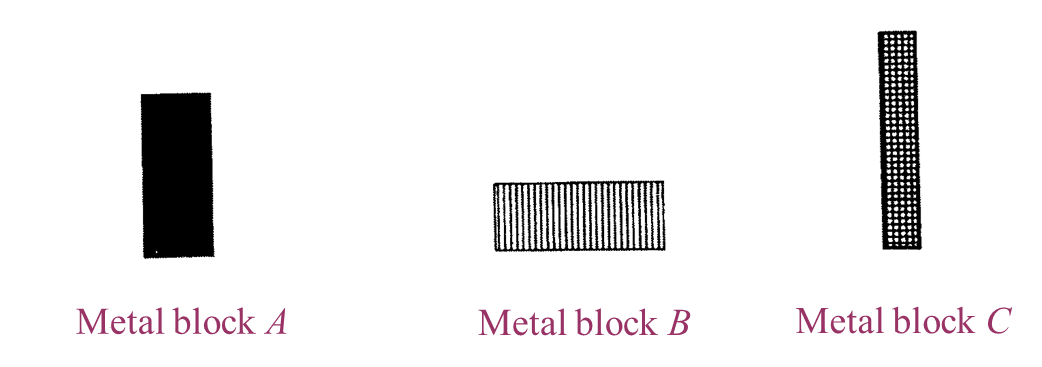Question 1:
Figure 1.1 shows an experiment to study the pressure produced by metal blocks, A and B of the same mass.
 Figure 1.1
Figure 1.1
Figure 1.2 shows the effect on the plasticine when metal blocks, A and B were dropped.
 Figure 1.2
Figure 1.2
(a) What is the controlled variable in this experiment? [1 mark]
(b) Write down one observation from the result of this experiment. [1 mark]
(c) State one inference that can be made based on the observation in Figure 1.2. [1 mark]
(d) Based on Figure 1.2, measure and record the depth of dent A. [1 mark]
(e) Metal block C in Figure 1.3 has the same mass as metal blocks, A and B.
 Figure 1.3
Figure 1.3
Predict the depth of dent produced on the plasticine when metal block C is dropped from the same height. [1 mark]
Answer:
(a)
The weight of the metal block (dropped from the same height).
(b)
The depth of dent A is more than the depth of dent B.
(c)
The surface area of A is smaller than the surface area of B.
(d)
The depth of dent A is 1 cm.
(e)
Deeper than dent A (or more than 1 cm).
Figure 1.1 shows an experiment to study the pressure produced by metal blocks, A and B of the same mass.
 Figure 1.1
Figure 1.1Figure 1.2 shows the effect on the plasticine when metal blocks, A and B were dropped.
 Figure 1.2
Figure 1.2(a) What is the controlled variable in this experiment? [1 mark]
(b) Write down one observation from the result of this experiment. [1 mark]
(c) State one inference that can be made based on the observation in Figure 1.2. [1 mark]
(d) Based on Figure 1.2, measure and record the depth of dent A. [1 mark]
(e) Metal block C in Figure 1.3 has the same mass as metal blocks, A and B.
 Figure 1.3
Figure 1.3Predict the depth of dent produced on the plasticine when metal block C is dropped from the same height. [1 mark]
Answer:
(a)
The weight of the metal block (dropped from the same height).
(b)
The depth of dent A is more than the depth of dent B.
(c)
The surface area of A is smaller than the surface area of B.
(d)
The depth of dent A is 1 cm.
(e)
Deeper than dent A (or more than 1 cm).